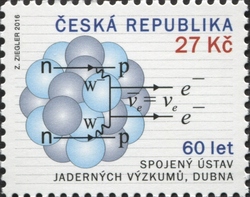Stamp: 60 Years of the Joint Institute for Nuclear Research in Dubna (Czech Republic 2016)
60 Years of the Joint Institute for Nuclear Research in Dubna (Czech Republic 2016)
16 March (Czech Republic ) within release 60 Years of the Joint Institute for Nuclear Research in Dubna goes into circulation Stamp 60 Years of the Joint Institute for Nuclear Research in Dubna face value 27 Czech koruna
| Stamp 60 Years of the Joint Institute for Nuclear Research in Dubna in catalogues | |
|---|---|
| WADP Numbering System - WNS: | WAD:CZ006.16 |
Stamp is horizontal format.
Stamp 60 Years of the Joint Institute for Nuclear Research in Dubna it reflects the thematic directions:
Nuclear engineering is the engineering discipline concerned with designing and applying systems that utilize the energy released by nuclear processes. The most prominent application of nuclear engineering is the generation of electricity. Worldwide, some 440 nuclear reactors in 32 countries generate 10 percent of the world's energy through nuclear fission. In the future, it is expected that nuclear fusion will add another nuclear means of generating energy. Both reactions make use of the nuclear binding energy released when atomic nucleons are either separated (fission) or brought together (fusion). The energy available is given by the binding energy curve, and the amount generated is much greater than that generated through chemical reactions. Fission of 1 gram of uranium yields as much energy as burning 3 tons of coal or 600 gallons of fuel oil, without adding carbon dioxide to the atmosphere
In physics, energy (from Ancient Greek ἐνέργεια (enérgeia) 'activity') is the quantitative property that is transferred to a body or to a physical system, recognizable in the performance of work and in the form of heat and light. Energy is a conserved quantity—the law of conservation of energy states that energy can be converted in form, but not created or destroyed. The unit of measurement for energy in the International System of Units (SI) is the joule (J).


